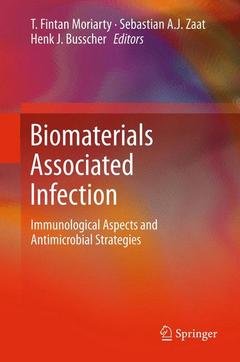Description
Biomaterials Associated Infection, 2013
Immunological Aspects and Antimicrobial Strategies
Coordinators: Moriarty Fintan, Zaat Sebastian A.J., Busscher Henk J.
Language: English
Subjects for Biomaterials Associated Infection:
Keywords
Anti-adhesive and Antibacterial Polymer Brushes; Anti-adhesive and Antibacterial Polymer Brushes; Anti-infective material; Antibacterial biomaterials; Antibiotic coating device; Antibiotic release; Antimicrobial biomaterials; Antimicrobial coating device; Antimicrobial device; Antimicrobial-Modified Vascular Catheters; BAI; Biomaterial dendritic cell interactions; Coagulase negative staphylococci infection; Colonization of tissue surrounding inserted medical devices; Dendritic cell-biomaterial interactions; Implant associated infection; Infection of inserted or implanted medical devices; Intracellular bacteria; Medical device associated infection; Peri-implant tissue colonization; Peri-implantitis biofilm; Preventive Strategies in VAP; Propionibacterium acnes; Quaternary ammonium Compounds; Rifampin biofilm; S; epidermidis biofilm interactions; S; epidermidis/ S; aureus biofilm; Silver containing biomaterials; Staphylococcal virulence factors; Staphylococcus aureus; Staphylococcus aureus implant associated infection; Staphylococcus aureus infection of implanted medical devices; Staphylococcus aureus medical device associated infection; Staphylococcus epidermidis; Staphylococcus epidermidis implant associated infection; Staphylococcus epidermidis infection of inserted medical devices; Staphylococcus epidermidis medical device associated infection; biofilm formation biomaterial; biomaterial antimicrobials; biomaterial associated infection; biomaterial implanted biomaterials immunology; foreign body response; immune function implanted biomaterial; immune response implanted; indwelling bladder catheter; indwelling bladder catheter infection; race for the surface; tissue colonisation in BAI; tissue infection
Publication date: 10-2014
566 p. · 15.5x23.5 cm · Paperback
Publication date: 09-2012
566 p. · 15.5x23.5 cm · Paperback
Description
/li>Contents
/li>Comment
/li>
Biomaterials associated infection (BAI) is one of the most common complications associated with implantation of any biomaterial regardless of form or function. These infections usually involve bacterial colonization and biofilm formation on the biomaterial itself, rendering the infection impervious to antimicrobials and host defenses. In addition, it is becoming increasingly clear that infection of the surrounding tissues also plays an important role in BAI, and that the infection may be influenced by the composition and design of the implanted biomaterial. In this book, worldwide leaders in the field address this critical problem in the translation of biomaterials research into clinical practice. The book begins with an emphasis on the latest research in the pathogenesis of BAI from microbiological, immunological, and materials science perspectives. The current state of the art in antimicrobial activation of biomaterials through surface modification and the incorporation of antimicrobial agents is then discussed. In the concluding chapters, successful translation of a selection of antimicrobial technologies from preclinical research into clinical use is described alongside a discussion of the utility of these devices and perspectives for future development. This book is essential reading for researchers and clinicians who are interested in understanding the fundamentals of BAI, the latest in antimicrobial materials research, and the state of the art in clinically available antimicrobial containing medical devices.
Preface
PART 1. The Pathogenesis of Medical Device associated Infection
Chapter 1: Biomaterial associated infection: a perspective from the clinic
Chapter 2: Staphylococcus epidermidis in biomaterial associated infection
Chapter 3: Staphylococcal virulence factors
Chapter 4: Propionibacterium acnes: a new emerging pathogen in biomaterial associated infection
Chapter 5: Bridging the gap between in vitro and in vivo testing for Biomaterial associated infection
Chapter 6: Biomaterial-dependent characteristics of the foreign body response and S. epidermidis biofilm interactions
Chapter 7: Dendritic cell-biomaterial interactions: implications for the onset and development of the foreign body response
Chapter 8: Tissue Colonisation in Biomaterial-Associated Infection
Chapter 9: Treatment options for medical device associated infection
Chapter 10: Novel antimicrobial strategies: honey and antimicrobial peptides
Chapter 11: Infections associated with implanted dental devices
Chapter 12: Animal models of orthopedic implant related infection
PART 2: Biomaterial-based Strategies to Reduce Medical Device Associated Infection
Chapter 13: Antimicrobial medical devices in preclinical development and clinical use
Chapter 14: Silver containing biomaterials
Chapter 15: Quaternary ammonium Compounds
Chapter 16: Anti-adhesive and Antibacterial Polymer Brushes
PART 3: Clinical applications, case studies
Chapter 17: Orthopaedic device design and antibiotic coatings reduce infection rates
Chapter 18: The indwelling bladder catheter: attempts to prevent infection and the development of bacterial biofilms
Chapter 19: Antimicrobial-Modified Vascular Catheters
Chapter 20: Topical Antimicrobial Containing Biomaterials for Peri-Implant Infections in the Oral Cavity
Chapter 21: Preventive Strategies in VAP: Focus on Silver-Coated Endotracheal Tubes
Index
PART 3: Clinical applications, case studies
Chapter 17: Orthopaedic device design and antibiotic coatings reduce infection rates
Chapter 18: The indwelling bladder catheter: attempts to prevent infection and the development of bacterial biofilms
Chapter 19: Antimicrobial-Modified Vascular Catheters
Chapter 20: Topical Antimicrobial Containing Biomaterials for Peri-Implant Infections in the Oral Cavity
Chapter 21: Preventive Strategies in VAP: Focus on Silver-Coated Endotracheal Tubes
Index
Provides a clinical perspective to set research directions
Summarizes the pathogenicity of the most common bacterial species isolated in BAI
Covers both biofilms and tissue reservoirs as modes of infection
Presents state-of-the-art issues of immune function in the vicinity of implanted biomaterials
Describes the latest technologies for antimicrobial activation of biomaterials
Includes supplementary material: sn.pub/extras
These books may interest you

Racing for the SurfacePathogenesis of Implant Infection and Advanced Antimicrobial Strategies 158.24 €



